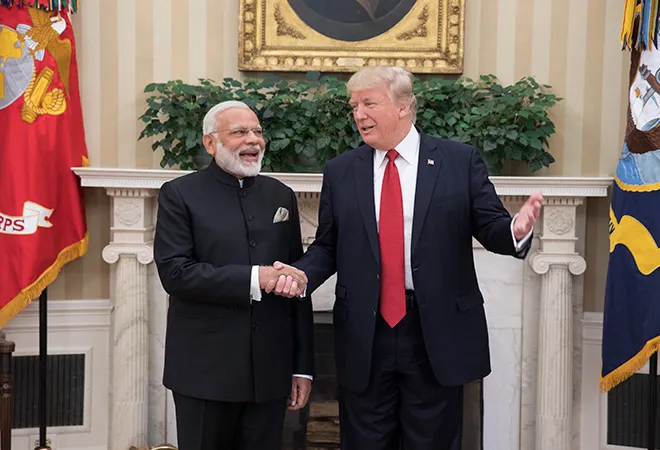Nine months is a long time in politics. But with the next United States (US) presidential election coming up in November, Donald Trump is feeling ascendant. Within 72 hours this week, several developments took place that further improve his prospects for re-election.
On Monday, when the state of Iowa held the first vote to select the Democratic Party’s nominee for president, the process was dogged by controversy. The Iowa Caucuses — comprising local meetings to select representatives supporting individual candidates — hit a technical snag, meaning that results were delayed. As the confirmed results trickled in, it appeared that Pete Buttigieg, the 38-year-old former mayor of a small town in Indiana, had won the most delegates, even though veteran Senator Bernie Sanders may have won the most votes. With Buttigieg and Sanders representing two wings of the party, the Democrats leave Iowa more fractured than ever. Meanwhile, the Democrats’ organisation in at least one pivotal state appeared woefully incompetent.
On Tuesday, Trump delivered his annual State of the Union address to the US Congress. This occasion not only saw him extolling his various accomplishments, but was marked by political theatre reminiscent of the president’s prior career as reality television show personality. Rightwing radio commentator Rush Limbaugh was presented with one of the US’ highest civilian honours. An enlisted military officer deployed in Afghanistan was reunited with his family. Democrats refused to applaud, several boycotted the address, and Speaker Nancy Pelosi tore up the text of Trump’s speech sitting right behind him. It was a moment of triumphalism for Trump in a house bitterly divided.
On Wednesday, the US Senate voted to acquit Trump on charges of abuse of power and obstruction of the Congress, both related to his linking military assistance to Ukraine with domestic US political objectives. While the acquittal was along predictable party lines, Senator Mitt Romney, himself a former Republican nominee for president, voted with Democrats to remove Trump from office. Romney’s surprise decision mitigated what might have otherwise been another unambiguous victory for Trump.
These developments have occurred just as Trump’s popularity has enhanced. The overall US economy and employment remain strong, with one recent estimate suggesting the largest private sector job growth in four-and-a-half years. On foreign policy, Trump’s escalation with Iran burnished his standing following the assassination by the US of Iranian General Qasem Soleimani and the accidental downing by Iran of a civilian airliner. On trade, Trump has recently concluded a “Phase One” deal with China, and successfully renegotiated a US-Mexico-Canada trade agreement (USMCA) on more favourable terms. His tax cuts have found favour with middle-class constituents, his judicial appointments have pleased Christian conservatives, and his trade policies have appealed to certain business interests and trade unions. This creates a strong base upon which he will now seek re-election.
It is amid this context that Trump may be headed to India. The White House has yet to confirm Trump’s expected visit this month, although preparations have begun in earnest. The US is seeking to conclude a modest bilateral deal with India that will bring an end to almost three years of trade hostilities. But the president’s top trade negotiator Robert Lighthizer — buoyant from concluding tough negotiations with China, Japan, Canada, and Mexico — appears eager to drive a hard bargain and not let India off the hook easily. A significant defence sale is another item awaiting conclusion. Trump also thrives on big crowds, which he hopes will await him in India. While these items remain at the top of the US president’s priorities, given their political value, his government is seeking other deliverables, including cooperation in third countries as part of the US and India’s Indo-Pacific convergence. Several other US officials are expected to visit India later in the year to follow up substantively on various aspects of India policy.
If Trump comes to India riding high, it will be important to recall a few points. First, US elections are always competitive affairs and opinion can change dramatically in a matter of months, as it happened in 2008 and again in 2016. That being said, US presidential elections tend to favour incumbent presidents (only four have lost in the past century). Much will depend upon the state of the US economy.
Second, Trump’s India visit will not be a partisan affair, even if the president chooses to portray it as such. After all, the Indian government invited his predecessor Barack Obama, a Democrat, as chief guest of Republic Day in 2015. Efforts will continue to be made to engage Democrats, despite their internal divisions, including presidential candidates and members of the US Congress.
Finally, while Trump will highlight the aspects of engagement with India that serve his political interests, the real significance for India will be at a more mundane level. The wide gulfs that existed between New Delhi and Washington on trade, Russia, Iran, and Afghanistan have been mended over the past six months, while cooperation on security and terrorism has continued apace. Trump’s theatrics are not a sideshow, for they have real implications. But neither should they constitute the most important story in India-US relations from New Delhi’s vantage point.
This commentary originally appeared in Hindustan Times.
The views expressed above belong to the author(s). ORF research and analyses now available on Telegram! Click here to access our curated content — blogs, longforms and interviews.




 PREV
PREV

